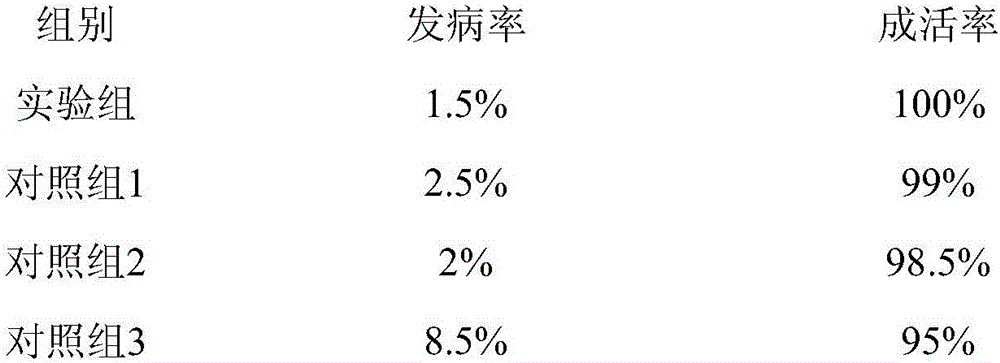Silky baby chick disease resisting method
A technology for silky chickens and silky chickens, applied in the field of poultry breeding, can solve problems such as affecting the growth and development and survival rate of chicks, weak resistance to disease germs, affecting economic benefits, etc., so as to inhibit the growth of harmful germs and improve immunity. strength, improve immune function
- Summary
- Abstract
- Description
- Claims
- Application Information
AI Technical Summary
Problems solved by technology
Method used
Image
Examples
Embodiment 1
[0044] A disease-resistant method for silkie chicklings, including selection of chicklings and management of chicklings:
[0045] Choose chickens with clear and crisp calls, healthy and lively, active eyes, sensitive to the surrounding environment, elastic chicken body, good contraction of the touch agent, and strong legs. The chicks are hatched from breeding eggs produced by 24-week-old, robust, well-proportioned, healthy and disease-free breeding hens, and the breeding eggs are sterilized before hatching. The feed for the breeding hens during laying eggs is: mixed by the following raw materials in parts by weight: 60 parts of corn flour, 2 parts of bone meal, 20 parts of soybean meal, 0.2 part of vitamins, 0.1 part of table salt, and 0.2 part of flaxseed , 1 part of purslane, 1 part of physalis, 2 parts of mulberry leaves, and 0.1 part of small peptide.
[0046] Described chick management comprises following control points:
[0047] a. Management of the brooding room: Befo...
Embodiment 2
[0053] A disease-resistant method for silkie chicklings, including selection of chicklings and management of chicklings:
[0054] Choose chickens with clear and crisp calls, healthy and lively, active eyes, sensitive to the surrounding environment, elastic chicken body, good contraction of the touch agent, and strong legs. The chicks are hatched from eggs produced by 80-week-old, healthy, well-proportioned, healthy and disease-free breeding hens, and the breeding eggs are sterilized before hatching. The feed for the breeding hens during egg laying is as follows: by weight, it is mixed with the following raw materials: 70 parts of corn flour, 4 parts of bone meal, 25 parts of soybean meal, 0.5 part of vitamins, 0.3 part of table salt, and 0.5 part of flaxseed , 3 parts of purslane, 2 parts of physalis, 3 parts of mulberry leaves, and 0.2 parts of small peptide.
[0055] Described chick management comprises following control points:
[0056] a. Management of the brooding room:...
Embodiment 3
[0061] A disease-resistant method for silkie chicklings, including selection of chicklings and management of chicklings:
[0062] Choose chickens with clear and crisp calls, healthy and lively, active eyes, sensitive to the surrounding environment, elastic chicken body, good contraction of the touch agent, and strong legs. The chicks are hatched from breeding eggs produced by 50-week-old, healthy, well-proportioned, disease-free breeding hens, and the breeding eggs are sterilized before hatching. The feed for the breeding hens during laying eggs is: mixed by the following raw materials in parts by weight: 65 parts of corn flour, 3 parts of bone meal, 23 parts of soybean meal, 0.3 parts of vitamins, 0.2 parts of table salt, and 0.3 parts of flaxseed , 2 parts of purslane, 2 parts of physalis, 3 parts of mulberry leaves, and 0.1 part of small peptide.
[0063] Described chick management comprises following control points:
[0064] a. Management of the brooding room: Before the...
PUM
 Login to View More
Login to View More Abstract
Description
Claims
Application Information
 Login to View More
Login to View More - R&D Engineer
- R&D Manager
- IP Professional
- Industry Leading Data Capabilities
- Powerful AI technology
- Patent DNA Extraction
Browse by: Latest US Patents, China's latest patents, Technical Efficacy Thesaurus, Application Domain, Technology Topic, Popular Technical Reports.
© 2024 PatSnap. All rights reserved.Legal|Privacy policy|Modern Slavery Act Transparency Statement|Sitemap|About US| Contact US: help@patsnap.com








